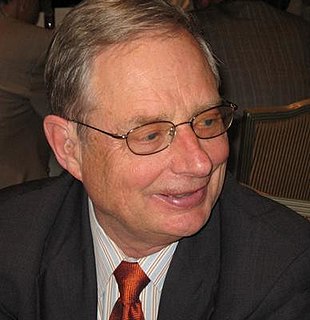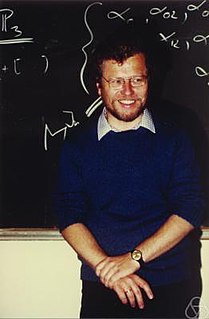Related Research Articles

In arithmetic geometry, the Mordell conjecture is the conjecture made by Louis Mordell that a curve of genus greater than 1 over the field Q of rational numbers has only finitely many rational points. In 1983 it was proved by Gerd Faltings, and is now known as Faltings's theorem. The conjecture was later generalized by replacing Q by any number field.
In mathematics, in particular algebraic geometry, a moduli space is a geometric space whose points represent algebro-geometric objects of some fixed kind, or isomorphism classes of such objects. Such spaces frequently arise as solutions to classification problems: If one can show that a collection of interesting objects can be given the structure of a geometric space, then one can parametrize such objects by introducing coordinates on the resulting space. In this context, the term "modulus" is used synonymously with "parameter"; moduli spaces were first understood as spaces of parameters rather than as spaces of objects. A variant of moduli spaces is formal moduli.

Don Bernard Zagier is an American-German mathematician whose main area of work is number theory. He is currently one of the directors of the Max Planck Institute for Mathematics in Bonn, Germany. He was a professor at the Collège de France in Paris from 2006 to 2014. Since October 2014, he is also a Distinguished Staff Associate at ICTP.
In algebraic geometry, a moduli space of (algebraic) curves is a geometric space whose points represent isomorphism classes of algebraic curves. It is thus a special case of a moduli space. Depending on the restrictions applied to the classes of algebraic curves considered, the corresponding moduli problem and the moduli space is different. One also distinguishes between fine and coarse moduli spaces for the same moduli problem.

Bertram Kostant was an American mathematician who worked in representation theory, differential geometry, and mathematical physics.

Phillip Augustus Griffiths IV is an American mathematician, known for his work in the field of geometry, and in particular for the complex manifold approach to algebraic geometry. He was a major developer in particular of the theory of variation of Hodge structure in Hodge theory and moduli theory. He also worked on partial differential equations, coauthored with Shiing-Shen Chern, Robert Bryant and Robert Gardner on Exterior Differential Systems.

Wolf Paul Barth was a German mathematician who discovered Barth surfaces and whose work on vector bundles has been important for the ADHM construction. Until 2011 Barth was working in the Department of Mathematics at the University of Erlangen-Nuremberg in Germany.
In mathematics, Arakelov theory is an approach to Diophantine geometry, named for Suren Arakelov. It is used to study Diophantine equations in higher dimensions.
In mathematics, a stable vector bundle is a vector bundle that is stable in the sense of geometric invariant theory. Any holomorphic vector bundle may be built from stable ones using Harder–Narasimhan filtration. Stable bundles were defined by David Mumford in Mumford (1963) and later built upon by David Gieseker, Fedor Bogomolov, Thomas Bridgeland and many others.
In mathematics, the Bogomolov–Miyaoka–Yau inequality is the inequality
In mathematics, the Hitchin integrable system is an integrable system depending on the choice of a complex reductive group and a compact Riemann surface, introduced by Nigel Hitchin in 1987. It lies on the crossroads of algebraic geometry, the theory of Lie algebras and integrable system theory. It also plays an important role in geometric Langlands correspondence over the field of complex numbers; related to conformal field theory. A genus zero analogue of the Hitchin system was discovered by R. Garnier somewhat earlier as a certain limit of the Schlesinger equations, and Garnier solved his system by defining spectral curves.. Almost all integrable systems of classical mechanics can be obtained as particular cases of the Garnier/Hitchin system or their common generalization defined by Bottacin and Markman in 1994.

Christopher Deninger is a German mathematician at the University of Münster. Deninger's research focuses on arithmetic geometry, including applications to L-functions.
Annamalai Ramanathan was an Indian mathematician in the field of algebraic geometry, who introduced the notion of Frobenius splitting of algebraic varieties jointly with Vikram Bhagvandas Mehta in. The notion of Frobenius splitting led to the solution of many classical problems, in particular a proof of the Demazure character formula and results on the equations defining Schubert varieties in general flag manifolds.

Richard Paul Winsley Thomas FRS is a British mathematician working in several areas of geometry. He is a professor at Imperial College London. He studies moduli problems in algebraic geometry, and ‘mirror symmetry’—a phenomenon in pure mathematics predicted by string theory in theoretical physics.
In differential geometry, algebraic geometry, and gauge theory, the Kobayashi–Hitchin correspondence relates stable vector bundles over a complex manifold to Einstein–Hermitian vector bundles. The correspondence is named after Shoshichi Kobayashi and Nigel Hitchin, who independently conjectured in the 1980s that the moduli spaces of stable vector bundles and Einstein–Hermitian vector bundles over a complex manifold were essentially the same.

Scott A. Wolpert is an American mathematician specializing in geometry. He is a Professor at the University of Maryland.
Carlos Tschudi Simpson is an American mathematician, specializing in algebraic geometry.

Lawrence Man Hou Ein is a mathematician who works in algebraic geometry.

In mathematics, a Siegel modular variety or Siegel moduli space is an algebraic variety that parametrizes certain types of abelian varieties of a fixed dimension. More precisely, Siegel modular varieties are the moduli spaces of principally polarized abelian varieties of a fixed dimension. They are named after Carl Ludwig Siegel, the 20th-century German number theorist who introduced the varieties in 1943.

Frank-Olaf Schreyer is a German mathematician, specializing in algebraic geometry and algorithmic algebraic geometry.
References
- ↑ biographical information from American Men and Women of Science, Thomson Gale 2004
- ↑ David Gieseker at the Mathematics Genealogy Project